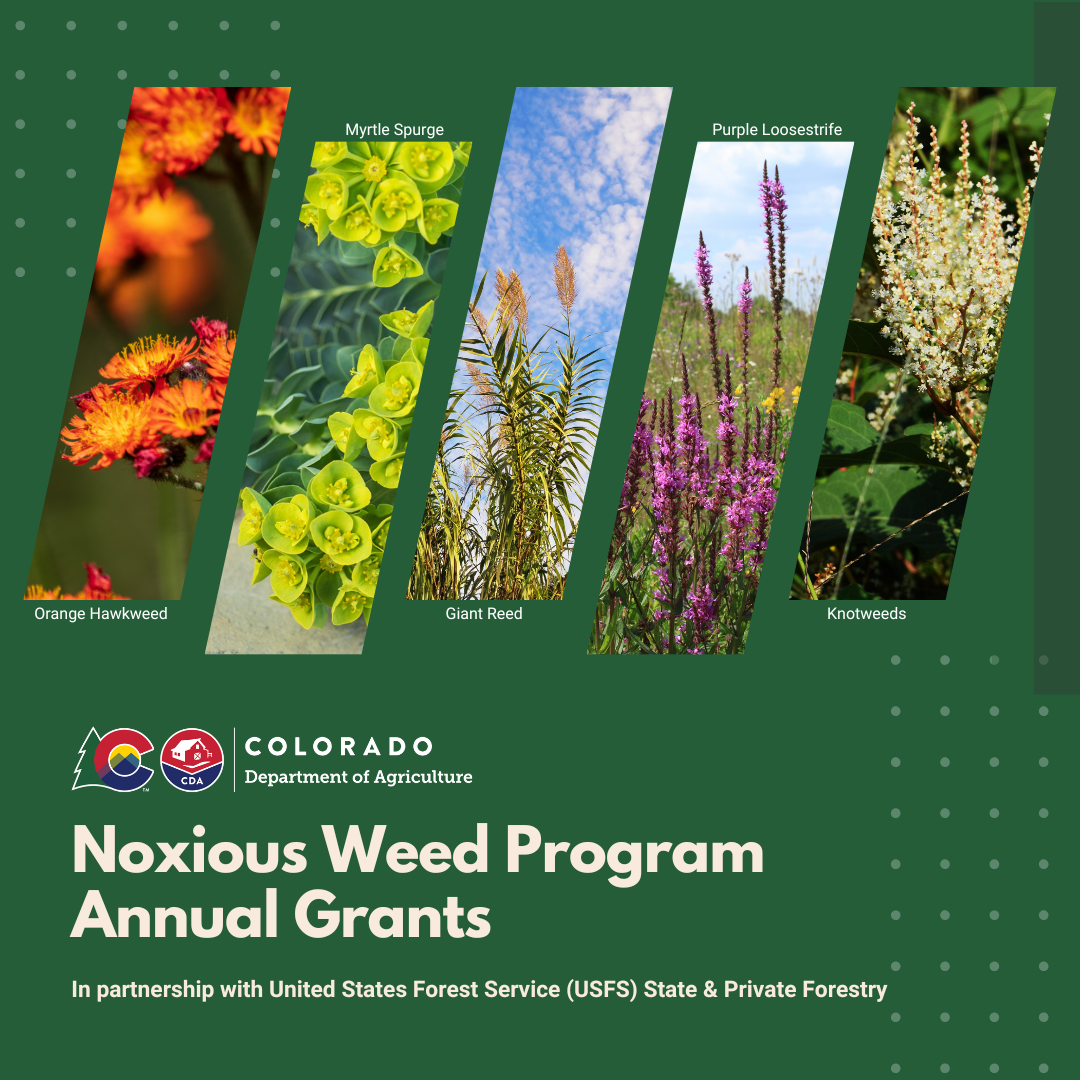Noxious Weed Program Annual Grants
The 2026 Noxious Weed Annual Grant Cycle is officially closed! Thank you so much to everyone who submitted an application. We truly appreciate your interest and effort!
Our Grants Review Committee will now begin reviewing all submissions. You can expect to hear back from us regarding award decisions around Friday, February 13th.
2026 Annual Noxious Weed Grant Timeline
This estimated timeline is for information and planning purposes only and may be subject to change depending on the needs of the State.
Friday, October 31, 2025
RFA Release Date
Friday, December 5, 2025
Deadline to submit questions to CDA via email by 5:00 pm MST
Monday, December 9, 2025
Q&A Posted Online (no later than) 5:00 pm MST
Monday, December 15, 2025
Application Submission Deadline at 5:00 pm MST
Friday, February 13, 2026
Estimated Notification of Award
February 15 - May 31, 2026
Statement of Work Development Period
March 15 - May 31, 2026
Estimated Contract Issuance Period
Have a 2025 Grant with the Noxious Weed Program?
We are approaching the end of the grant cycle, and many 2025 Noxious Weed Program Annual Grants will be closing soon. Please note that the required Final Report documents have changed this year to help us standardize data and effectively report outcomes to the new State Grants Dashboard. The new forms will help us capture more consistent data on grant successes.
1. New Final Report Requirements (Effective Immediately)
Required Close-Out Documents (Due by Grant Expiration Date):
- Project Narrative (Word Document): A narrative document designed to capture the successes and outcomes of your grant
- Proof of EDDMapS Data Entry: Documentation that you have submitted your project data to EDDMapS.
- Report Tables (Excel Booklet): A new booklet with separate tabs for:
- Grant Overview
- Species Treated
- Outreach Efforts
- Budget
2. Key Deadlines and Invoice Submission
Your grant's official expiration date is listed on the front page of your POGG1 document. All three required close-out documents (listed above) are due by this expiration date.
Invoice Submission: Once we have reviewed and approved your Final Report documents, you will have 45 days to submit your invoice and all supporting documentation.
Your final deadline for submitting the invoice and supporting documents in 45 days after your grant expires.
Forms: To make edits, please download or create a copy of the documents
Final Report Form (Word Document)
Final Report Tables (Excel Spreadsheet)
Noxious Weed Program Annual Grants
The Noxious Weed Management Grants are funded through the Noxious Weed Management Fund and the United States Forest Service (USFS) State & Private Forestry Grants.
Approximately $450,000 of Noxious Weed Management Fund is available for the 2026 grant round. Approximately $50,000 of United States Forest Service (USFS) State & Private Forestry (SPF) funding is also available.
The primary objectives of the Noxious Weed Management Fund (NWMF) grant program are to:
- Provide additional financial resources to entities engaged in cooperative efforts to eradicate and/or contain state-listed noxious weeds,
- Produce measurable outcomes across Colorado for noxious weed management, and
- Assist new or underfunded weed management programs, especially in regions where additional resources are needed.

Eligibility
Eligible applicants for the 2026 grant cycle are limited to local governing bodies, weed control districts, and cooperative weed management areas in Colorado that demonstrate project capacity and compliance with the Colorado Noxious Weed Act (State/Federal agencies can be partners but not applicants).
How to apply
To apply, first carefully review the RFA and complete the Google Form Application; then, by 5:00 pm on Monday, December 15, 2025, forward the submission confirmation email (changing the subject line to "2026 CDA Grant Application - [ORGANIZATION NAME]") to weeds@state.co.us with the required Budget Table, Species Table, and proposed treatment map(s) attached (using Google Drive or a Zip file for large attachments).
Questions?
For application questions, contact the CDA Noxious Weed Program staff only via email at weeds@state.co.us with the subject line "2026 Grant Question;" all official communications (including FAQ answers and clarifications) will be posted on the website and supersede any other information.
Grants Additional Information
Noxious Weed Grants Webinar
All 2023 Noxious Weed grant recipients must watch this webinar and fill out the post-webinar questions as part of the 2023 grant process.
You can view the webinar on the right or on YouTube. Review the full agenda of the call.